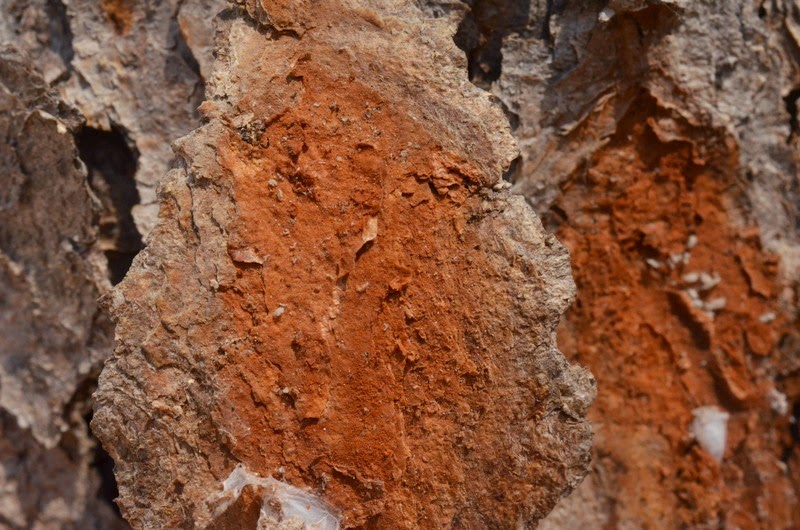 |
| Older lenticels on sugar maple (with gouge from squirrel), kind of looks like a monkey face |
This along with the next 3 posts will be heavy on the photographs, a way of representing the variation in morphology of lenticels, textures, "accessories", and color. Enjoy!
 |
| Velvet mite on bizarre ridges of hackberry. Lenticells are a yellowish color and rather non-descript as they age |
In his 1921 book,
Trees of New York State, Harry Philip Brown writes that lenticels are "of minor value in identification." I would agree, sort of. In twigs many species have small whitish lenticels that all kind of look the same. But when we look closely, particularly at older branches, we find them adeptly telling us a great deal. Because bark is impervious to both water and gas, no exchange can happen through this part of the tree's body. Lenticels, like the stomata of a leaf, are the mouth holes, pores, or excrescences that erupt through a tree's bark, allowing the exchange of water and gas (especially oxygen). Without oxygen, the living cells of the bark would die.
 |
| Diamond shaped lenticels of quaking aspen bark, looks like a punk's studded belt |
I have a hypothesis that primary succession species should have a total surface area of lenticels per node than more shade tolerant species to fuel the rapid growth of cells. While I found several research papers that document shifts within a species over different growing conditions (like
this one, which shows that red-osier dogwoods growing in wet conditions have more lenticels than those growing on drier sites), I haven't found any research pointing to a corresponding link between lenticel abundance on a species and photosynthetic rates, growth rates, or shade tolerance. The red-osier paper makes me wonder if perhaps a greater abundance of lenticels is allied more with wetland species that with speed of growth. The paper states that lenticels are able to provide roots with oxygen to a certain degree in anoxic conditions.
 |
| Orbiculate lenticels of staghorn sumac bark |
 |
| Vertical orientation of lenticels on Glossy Buckthorn twig |
|
|
Punctate lenticels on red oak
|
Variation in lenticels from one species to another fall into the following categories:
- The shape of the lenticels can be spotted or punctate (most species), rounded or orbiculate (boxelder, sumac) or linear/elongate (cherry, birch, glossy buckthorn)
- Their orientation either vertically or horizontally (transverse or perpendicular) to the branch. In thinner barked species, the lenticels will remain active over a longer period of time. As the tree's trunk/branch thickens, the lenticels expand and on something like paper birch, the lenticels can be quite long.
- The color of the lenticels can be in sharp contrast to the twig or roughly the same hue; they can be white, yellow, orange, brown, red, or black (the vast majority are in the white range)
- The texture can be fuzzy, or powdery and break apart when rubbed.
- Lenticel abundance can be great or small
- Placement can be distributed evenly over the bark or concentrated on the underside of the twig or nearest the nodes.
- As a tree ages, lenticels become distorted in different ways.
 |
| Far fewer lenticels were on the underside (left) of alternate-leaf dogwood than on upper surface (right) |
 |
| The enormous elongate, horizontal lenticels on paper birch, with my thumb for scale |
.jpg) |
| Twig and mature bark of glossy buckthorn, showing distortion of aged lenticels from vertical to horizontal orientation |
In black cherry the lenticels elongate horizontally as the tree matures. As the bark thickens the lenticels eventually close off. Over time the plates (people describe them as potato chip-esque) fall off. The exposed surfaces are a deep burnt orange before fading to a darker gray, and lack any visible sign of lenticels. The image to the right is of the backside of the "lenticeled" plate on the left. It lacks any sign of the horizontal lines.
Contrast this with paper birch bark. The lenticels continue to elongate as the tree ages and the bark thickens. Rather than having a thicker, corky bark, paper birch sheds barks in sheets (each layer of bark represents one year of growth). In the image above you can see the lenticels marking the inner bark beneath a relatively thin outer bark. The tree was about 16" in diameter.







.jpg)





No comments:
Post a Comment